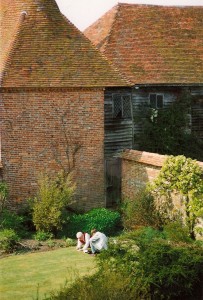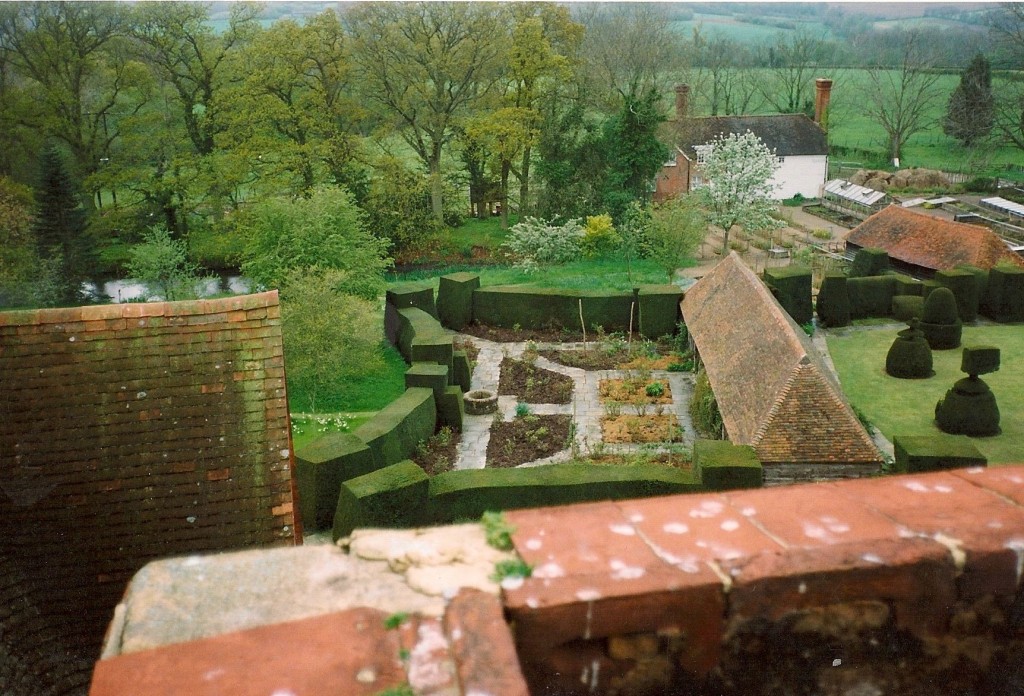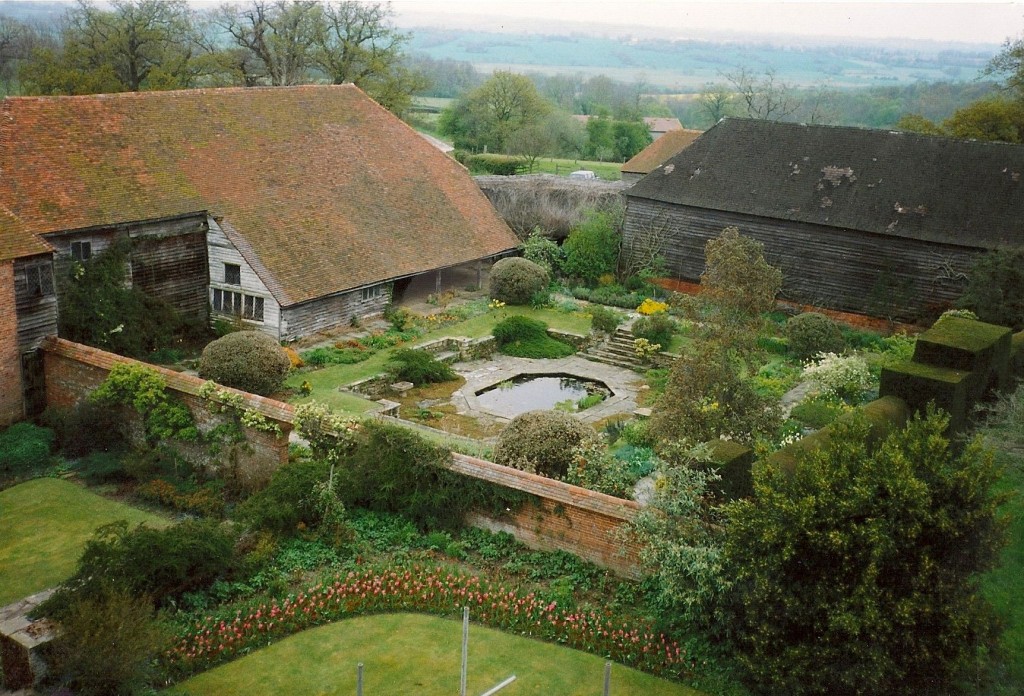I was hunting for a pretext on which to show off some rare photos of Great Dixter (one of my favourite places in the world, and about which I tend to rant a little too often and at too great a length).
It didn’t take long.
But you’ll have to read to the end to get it. I promise it will be worth it. There’s images there that you won’t see anywhere else.
There’s this place up on the roof at Great Dixter which is hidden from any outside view, and where there’s loads of skylights. It’s all lined with great sheets of thick oxidised lead, so as you climb out on hands and knees from the access window at the top of a ladder, you can’t help but feel like you’re absorbing fatal levels of poison.
But the views are worth it. You can see out on three sides – to the north, south and east. Above is the lavender garden, or the parliament of birds. Below left is the Topiary Lawn, and right is the High Garden.
If you click on these images, you’ll see them full size. This part of the house isn’t open to the public, but there’s plenty of pics taken from here, some in Christopher Lloyd’s (the owner’s) books. What I really wanted to put out there were some pics taken from the huge chimney, right in the middle of the house, while the roof was under repair in 1991. Christopher Lloyd himself had never seen these views, despite living at Dixter all of his (then) 70 years.
Above is the old rose garden – back when it was a rose garden.
Above is the Barn Garden and Sunk Garden. In the foreground is a pretty dodgy blend of pink and red tulips. I was there when CL was explaining to his niece that the combination wasn’t really what he wanted, but they were the only tulips left after planting up the rest of the garden. “But the colour combination is dire, don’t you think?” was the consequent question. His highly characteristic answer? “As I said, they weren’t my first choice, but now you’ve described them that way, I’m beginning to see their virtues”.

And then there’s this, of CL and me planting in the Wall Garden. He was reclining on the lawn, writing notes on what we were planting. In this particular case, it was a daylily sent from Wisley – one that he’d commented favourably on on an earlier visit. The hilarious thing is that there was simply no chance of it surviving in that spot, right at the foot of an enormous Clematis heracleifolia that had been there forever, and is still there now. We both knew (though never mentioned) that the daylily was doomed. But a garden like that rarely has any open space for such odd arrivals, and anyway, it’s nicely reassuring that even a gardener of his astonishing abilities can be unrealistically optimistic, like the rest of us.
So what was the pretext? What can we possibly take away from this? I’ve just been up on the roof this afternoon, clearing guttering. It’s incredible how different the garden, and even our huge oak, looks from up there. To see a garden from an unusual angle literally changes your perspective, and often reveals opportunities you couldn’t see on the ground, or solutions to design problems you’ve been struggling with for ages. You don’t have to climb on the roof to get the effect. Lying flat on your back on a lawn and looking straight up can have be similarly revealing, or holding up a mirror, and seeing your garden in reverse. It always looks more mysterious and interesting as a mirror image, simply because we’re not desensitised to the view.
Sometimes it’s just a matter of seeing a garden right out of season. I was in a client’s garden this week just after massive sweeps of Miscanthus sinensis ‘Giganteus’, usually standing at at least 4m tall, had had their winter cut to the ground. I’d never before had such a clear view of the garden on this side of the house. It’s bare, I know, but hugely revealing to the designer.
More on this garden later..





What a revealing and unusual look at Great Dixter! Its amazing to have a bird’s eye view of all those gardens, particularly the wonderful Parliament of Birds, to see it all at once, and with the bonus of no tourists!! Please, show us more.
Great Dixter was the ‘wow’ garden of the Ross Tour of England this year.
Thanks for bringing out those pics, and I did love the planting scene..I will sit on the ground to plant more often!
There’s MILLIONS more where they came from Libby – you’d soon get sick of them. But it has been a huge privilege, over the years, to be able to take pics early in the morning and late in the afternoon and evening when there’s no one else there. As for the posture, CL was a great one for kneeling properly while weeding, never bending over or crouching, and always had a kneeling pad in his trug for this purpose. He thought it was completely ridiculous to take any other stance, but I’m usually in too much of a hurry, and weeding-on-the-run, so to speak. A proper kneel shows real commitment to the task. Hang on – I now realise I didn’t include the pic of him weeding, and I’m ranting on about an irrelevance.
Isn’t it strange how one man’s meat is another’s poison. Of all the English gardens I’ve visited, Great Dixter was the one that really disappointed me. I felt like I couldn’t breathe. Everything was so jam-packed with tiny little paths around the outside, and everyone jostling past each other like penguins with their arms pinned down to their sides. And it wasn’t a very busy day. I could never get any sense of the garden at all, other than claustrophobia. I don’t think every space is improved by planting something in it. Sometimes the hole is more important than the donut! From an aerial viewpoint I agree, it looks wonderful – a real living tapestry. However, at ground level I kept feeling like I wanted to step back to be able to see it better, but there was always a hedge right behind me. And this was a few years ago, before everything too close up became a bit blurry……
As you’d well imagine, you’re not the only one that doesn’t like Great Dixter. In my time there, I heard loads of people sneering at the number of weeds (and there were lots, twenty years ago), and the loud colour schemes. Christopher Lloyd was impervious to such criticism, as much of that was deliberately provocative.
In CL’s biography published last year the author, Stephen Anderton, has a go at the relentlessness of the intensity, claiming that there needs to be more quiet space, which shares some ground with your observation.
But while we’re evaluating, I find it curious that I’ve never heard anyone make any sort of evaluation of Lutyen’s design of the garden. For my part, I reckon that it’s something of a workhorse design. I don’t see any Lutyen’s genius on display here. The circular steps are sublime, and the way he used the old farm buildings is clever, but as an overall, I think that its strongest point is simply that it provided a fabulous playground within which the Lloyd’s could play with plants. Which they did – the last of them devoting his whole life to it, and doing it like no one else.